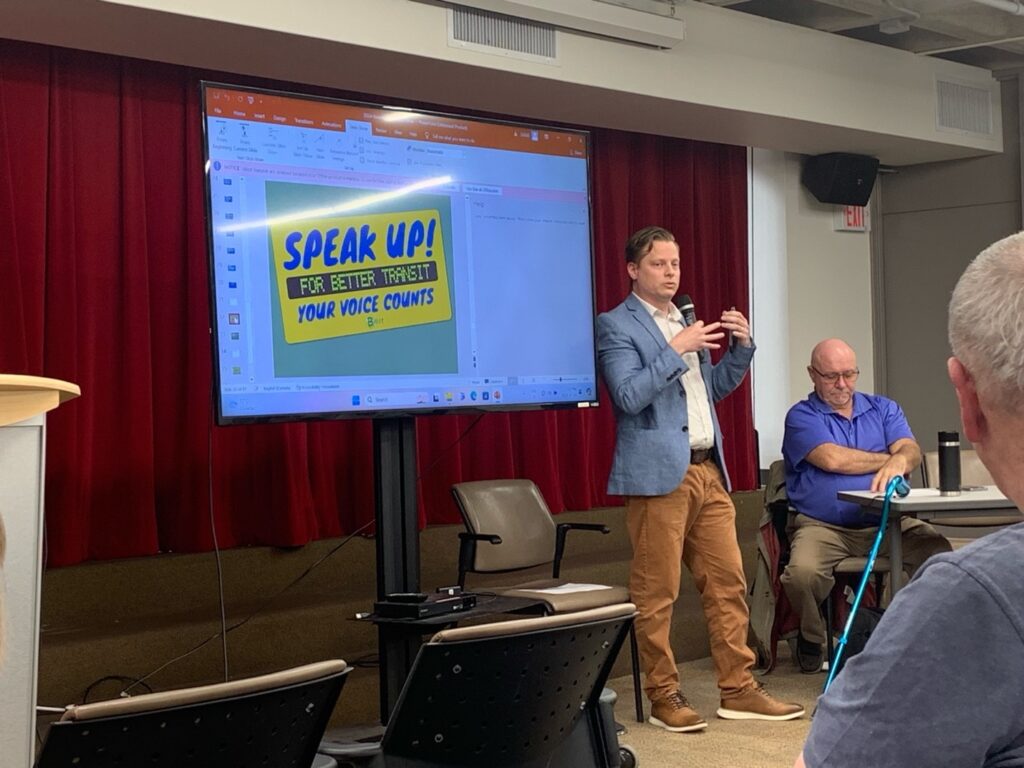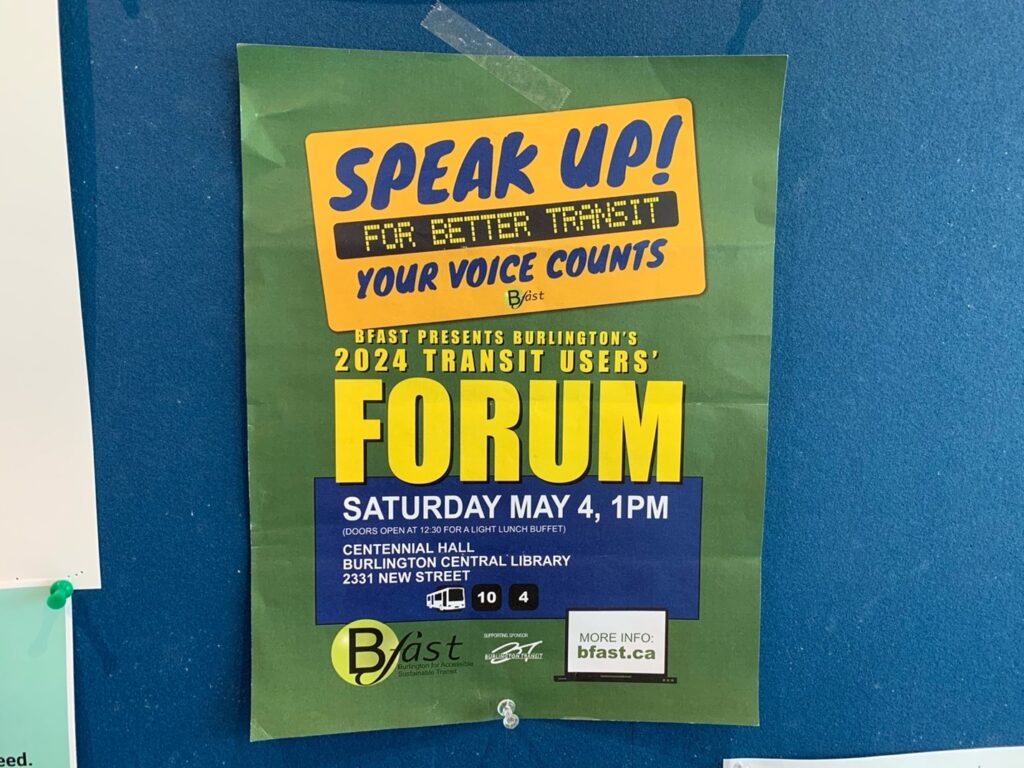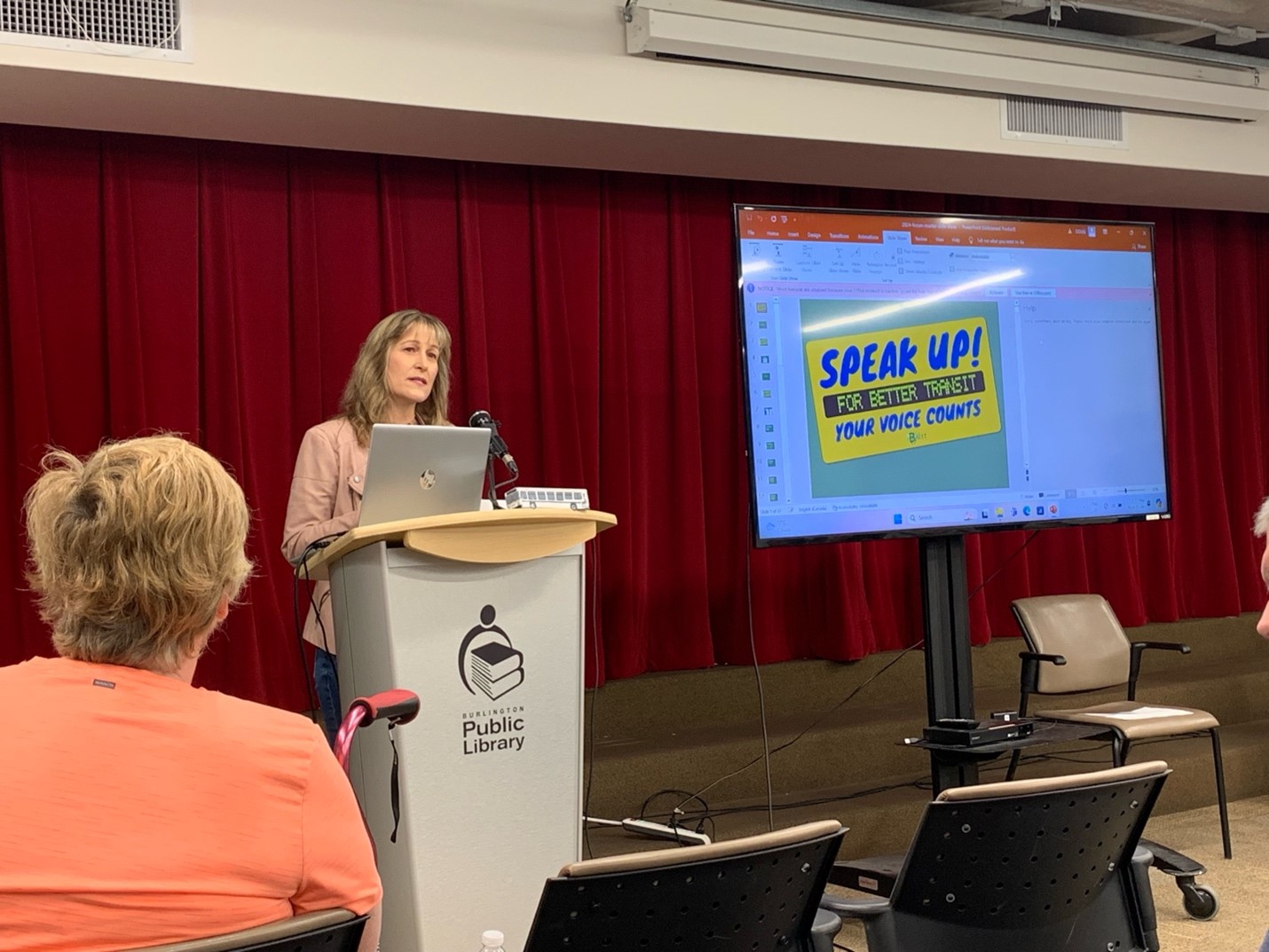By Jack Brittle, Local Journalism Initiative Reporter
On May 4, Burlington for Accessible Sustainable Transit (BFAST) held their annual Transit Users’ Forum.
A panel of transit specialists was assembled for the event, held in the Centennial Hall of the Central Branch of Burlington Public Library.
Burlington Mayor Marianne Meed Ward and Halton Regional Chair Gary Carr were also in attendance and kicked off the forum by addressing the crowd.
Meed Ward spoke about the increased need for accessible transit and mentioned that city council is already discussing more investments in transit in the 2025 budget.
Carr mentioned that he has his seniors’ pass and encouraged anyone over the age of 65 to get theirs as well. Starting on August 1 of last year, seniors can ride on Burlington Transit for free. Youth aged 13–19 can also ride for free any time after 6 p.m. on weekdays and all day on weekends.
Emcee Collin Gribbons of BFAST then took some time to thank the sponsors of the event, which included Burlington Transit, Poverty Free Halton, and Partnering Aldershot, among others.
Gribbons then also showed the audience a slide, which revealed that Burlington’s transit system was given a C+ by the Toronto Region Board of Trade, while Oakville and Milton received a D-.
In another slide, Gribbons showcased the number of buses per 1000 residents in the cities of Guelph, Windsor, Oakville, Kingston, and Burlington, respectively.
Burlington came in last among these cities, with 0.33 buses per 1000 residents, with Guelph placing first with 0.56.
Gribbons spoke about the ways in which traffic negatively impacts our society and how more public transit can alleviate these issues.
“We know that heavy traffic lowers the quality of life,” Gribbons said. “It induces stress reactions that last far longer than the trip, and it’s more and more unsafe for pedestrians as well.”
“Pollution from cars has effects on our health. But a new research report sponsored by Environmental Defence Canada has shown a doubling of transit ridership, which saves 65 million tons of greenhouse gas emissions every year,” he continued.
He said that while BFAST supports the adoption of electric vehicles, they are not the “sole solution” to the environmental issue with transportation.
“Not only do they not solve congestion, the city is projecting a significant increase in traffic over the next decade or more, and EVs are not emission-free, even in Ontario, where most of our electricity is renewable,” Gribbons said.
“With average prices estimated as high as $75,000, EVs are not cheap, especially given the predilection for today’s huge cars,” Gribbons said. “They’re supposed to be cheaper to maintain, yet Hertz decided to ditch their entire EV fleet because of high maintenance costs.”
Gribbons cited some of these rising costs as part of the reason that in some cities, public transit ridership is up 20% from pre-pandemic levels.
He also spoke about some of the things that BFAST is requesting city council to do to improve transit, such as conducting a study on the economic benefits of transit and restoring the federal gas tax to 30%.
Gribbons also said he would like to see both citizens and organizations pursue funding from senior levels of government.
“It’s important that they fund operational spending as well as capital spending,” he said. “It’s really easy to buy a bus and send an MP to a ribbon-cutting ceremony. It’s harder to keep the transit system running.”
Gideon Forman, the transportation policy analyst for the David Suzuki Foundation, then took the stage to speak about the popularity and upsides of public transit.
“Across the province, every region, every demographic, old folks and younger folks … [exhibit a] strong majority and support for putting more money into public transit,” Forman said.
“Almost four in five Ontarians agree the feds and the province should put more money into public transit,” he continued.
Forman also cited a study conducted by the Canadian Urban Transit Association, which calculated that Canadian households could save over $12 billion annually by using transit instead of a car — which works out to $10,000 per household.
Rory Nisan, Ward 3 councillor and deputy mayor for the environment then took the stage to round out the panel of guest speakers.
He spoke about how the expected population increase in Burlington over the next 25 years is going to impact the planning around transit in the city.

“We may have 80,000, 100,000, 120,000 more residents here in Burlington,” Nisan said. “We’re planning for that mandated growth today. We’re planning for a busier, more full Burlington than we have now. And we’re planning around our major transit station areas, around GO stations in particular. So, there’s a future Burlington that would be oriented around public transit.”
After Nisan spoke, the Q&A portion of the forum began.
Questions largely focused on long bus wait times and inadequate access to transit, specifically for those with disabilities.
Citizens posed questions to not only the group of panellists but also to Catherine Baldelli, the director of Burlington Transit, as well as other employees from the city-run agency.
BFAST noted in a press release that “growth in demand and worsening traffic conditions are putting the service under pressure,” as evidenced by forum participants’ stales of long transit commute times — as much as four hours per day. Baldelli and her staff explained that shortages in terms of buses and operational and maintenance staff can also contribute to the issues of limited schedules and long commute times.
Transit signal priority is in the current Burlington Transit and city transportation department work plan to ameliorate the challenge of buses running late due to heavy traffic; once implemented, late-running buses will be given priority in going through intersections.
Nisan commented after the event about the importance of the forum and elected officials attending it.
“We have to do some leading, but we have to do a lot of listening as well,” Nisan said. “So, this has been a great forum for us to hear that for seven years now.”
He also said he was impressed with the turnout and spoke about some of the key issues and concerns that attendees voiced.
“There’s a ton of interest in getting more buses out, because when people worry about transfer times, it’s not that they’re waiting on a bus, what they’re really saying is we need more buses out there,” Nisan said. “So, I think that supports the trend that we have to go out and work.”

Oscar Gauthier, a McMaster University student who attended the event, said he found out about the forum through the posters on Burlington Transit buses. Gauthier said he has a general interest in transit and came to participate in something he enjoys.
He said that while initially his hobby was just rooted in trains and the different routes in Burlington, it evolved into a more political interest.
“It contributes to the fight against climate change and how transit can improve the city’s livability because you don’t have to destroy buildings for parking lots,” Gauthier said. “And, you don’t have to have wider roads that are hard to cross and whatnot. And there’s less pedestrian deaths because you don’t have as many individual people driving these machines that can kill so easily.”
BFAST Chair Doug Brown commented in their post-event press release, “We’re seeing a real change in attitudes towards transit as congestion and affordability take a bite out of our over-dependence on cars. We hope this forum further demonstrates to our elected representatives that despite the progress we’ve made over the past five years, there is still a lot to be done.
Brown continued, “Transit is one of the best tools in our kit to reduce pollution, end gridlock, make our streets safer and improve the quality of our urban life. We will continue to work with transit supporters, Burlington Transit and our municipal government to make better transit a reality in our community.”




